NVIDIA GeForce GTX 690 Review: Ultra Expensive, Ultra Rare, Ultra Fast
by Ryan Smith on May 3, 2012 9:00 AM ESTCrysis: Warhead
Kicking things off as always is Crysis: Warhead. It’s no longer the toughest game in our benchmark suite, but it’s still a technically complex game that has proven to be a very consistent benchmark. Thus even four years since the release of the original Crysis, “but can it run Crysis?” is still an important question, and the answer when it comes to setups using a pair of high-end 28nm GPUs is “you better damn well believe it.”
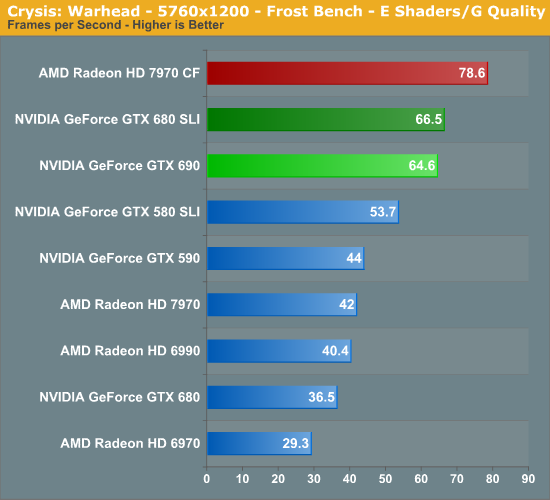
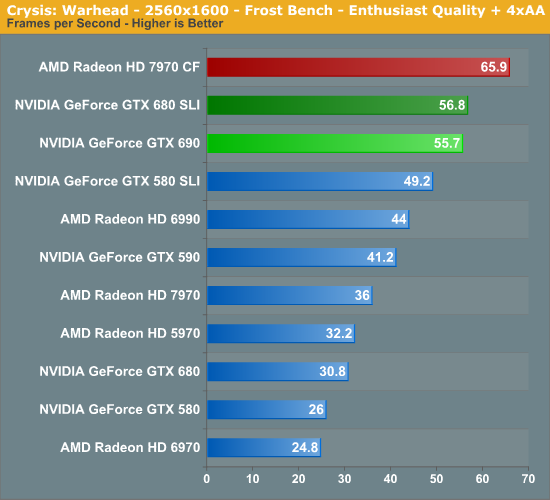
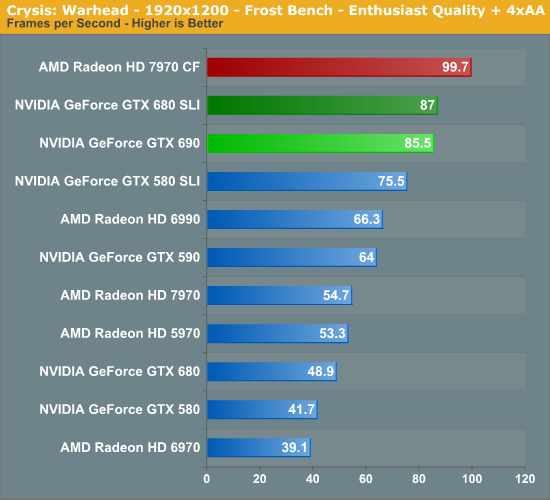
Crysis was a game that Kepler didn’t improve upon by a great deal compared to the Fermi based GTX 580. NVIDIA sees some good SLI scaling here, but AMD’s performance lead with a single GPU translates into an equally impressive lead with multiple GPUs; in spite of all of its capabilities the GTX 690 trails the 7970CF by 18% here. So long as AMD gets good Crossfire scaling here, there’s just no opening for Kepler to win, allowing AMD to handily trounce the GTX 690 here.
As for the intra-NVIDIA comparisons, the GTX 690 does well for itself here. Performance relative to the GTX 680 SLI at 2560 is 98%, which represents a 77% lead over the GTX 680. Overall performance is quite solid; at 55.7fps we’re nearly to 60fps on Enthusiast quality at 2560 with 4x MSAA, which is the holy grail for a video card. Even 5760 is over 60fps, albeit at lower quality settings and without AA.
It’s taken nearly 4 years, but we’re almost there; Crysis at maximum on a single video card.
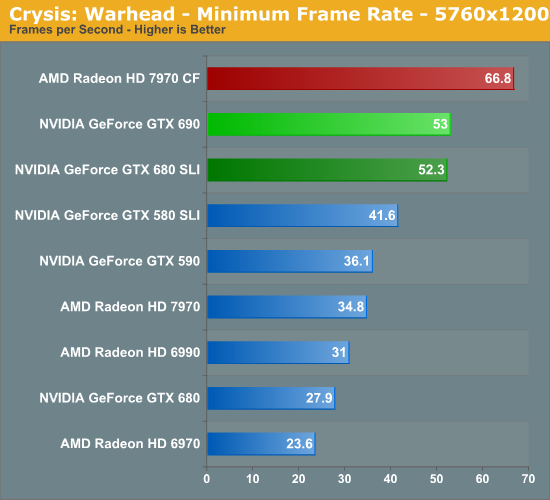

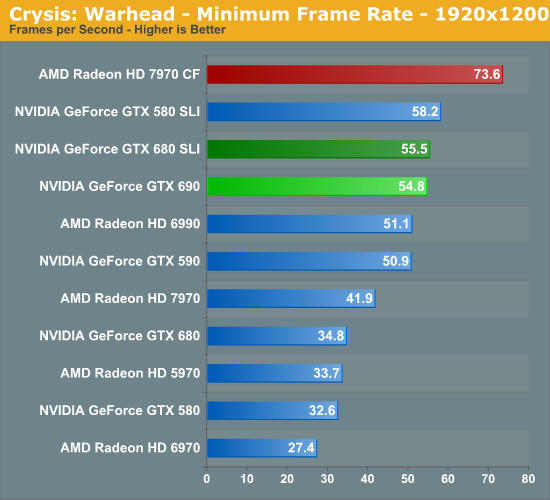
Our minimum framerates are much the same story for NVIDIA. The GTX 690 once again just trails the GTX 680 SLI, while interestingly enough the dual-GPU NVIDIA solutions manage to erode AMD’s lead at a single point: 2560. Here they only trail by 8%, versus 20%+ at 5760 and 1920. Though at 1920 we also see another interesting outcome: the GTX 580 SLI beats the GTX 680 SLI and GTX 690 in minimum framerates. This would further support our theory that the GTX 680 is memory bandwidth starved in Crysis, especially at the lowest performance points.










200 Comments
View All Comments
CeriseCogburn - Thursday, May 10, 2012 - link
The GTX680 by EVGA in a single sku outsells the combined total sales of the 7870 and 7850 at newegg.nVidia "vaporware" sells more units than the proclaimed "best deal" 7000 series amd cards.
ROFL
Thanks for not noticing.
Invincible10001 - Sunday, May 13, 2012 - link
Maybe a noob question, but can we expect a mobile version of the 690 on laptops anytime soon?trumpetlicks - Thursday, May 24, 2012 - link
Compute performance in this case may have to do with 2 things:- Amount of memory available for the threaded computational algorithm being run, and
- the memory IO throughput capability.
From the rumor-mill, the next NVidia chip may contain 4 GB per chip and a 512 bit bus (which is 2x larger than the GK104).
If you can't feed the beast as fast as it can eat it, then adding more cores won't increase your overall performance.
Joseph Gubbels - Tuesday, May 29, 2012 - link
I am a new reader and equally new to the subject matter, so sorry if this is a dumb question. The second page mentioned that NVIDIA will be limiting its partners' branding of the cards, and that the first generation of GTX 690 cards are reference boards. Does NVIDIA just make a reference design that other companies use to make their own graphics cards? If not, then why would anyone but NVIDIA have any branding on the cards?Dark0tricks - Saturday, June 2, 2012 - link
anyone who sides with AMD or NVIDIA are retards - side with yourself as a consumer - buy the best card at the time that is available AND right for your NEEDs.fact is the the 690 is trash regardless of whether you are comparing it to a NVIDIA card to a AMD card - if im buying a card like a 690 why the FUCK would i want anything below 1200 P
even if it is uncommon its a mfing trash of a $1000 card considering:
$999 GeForce GTX 690
$499 GeForce GTX 680
$479 Radeon HD 7970
and that SLI and CF both beat(or equal) the 690 at higher res's and cost less(by 1$ for NVIDIA but still like srsly wtf NVIDIA !? and 40$ for AMD) ... WHAT !?
furthermore you guys fighting over bias when the WHOLE mfing GFX community (companies, software developers is built on bias) is utterly ridiculous, GFX vendoers (AMD and NVIDA) have skewed results for games for the last decade + , and software vendors two - there needs to laws against specfically building a software for a particular graphics card in addition to making the software work worse on the other (this applies to both companies)
hell workstation graphics cards are a very good example of how the industry likes to screw over consumers ( if u ever bios modded - not just soft modded a normal consumer card to a work station card , you would know all that extra charge(up-to 70% extra for the same processor) of a workstation card is BS and if the government cleaned up their shitty policies we the consumer would be better for it)
nyran125 - Monday, June 4, 2012 - link
yep........Ultra expensive and Ultra pointless.
kitty4427 - Monday, August 20, 2012 - link
I can't seem to find anything suggesting that the beta has started...trameaa - Friday, March 1, 2013 - link
I know this is a really old review, and everyone has long since stopped the discussion - but I just couldn't resist posting something after reading through all the comments. Understand, I mean no disrespect to anyone at all by saying this, but it really does seem like a lot of people haven't actually used these cards first hand.I see all this discussion of nVidia surround type setups with massive resolutions and it makes me laugh a little. The 690 is obviously an amazing graphics card. I don't have one, but I do use 2x680 in SLI and have for some time now.
As a general rule, these cards have nowhere near the processing power necessary to run those gigantic screen resolutions with all the settings cranked up to maximum detail, 8xAA, 16xAF, tessellation, etc....
In fact, my 680 SLI setup can easily be running as low as 35 fps in a game like Metro 2033 with every setting turned up to max - and that is at 1920x1080.
So, for all those people that think buying a $1000 graphics card means you'll be playing every game out there with every setting turned up to max across three 1920x1200 displays - I promise you, you will not - at least not at a playable frame rate.
To do that, you'll be realistically looking at 2x$1000 graphics cards, a ridiculous power supply, and by the way you better make sure you have the processing power to push those cards. Your run of the mill i5 gaming rig isn't gonna cut it.
Utomo - Friday, October 25, 2013 - link
More than 1 year since it is announced. I hope new products will be better. My suggestion: 1 Add HDMI, it is standard. 2. consider to allow us to add memory / SSD for better/ faster performance, especially for rendering 3D animation, and otherTPLVG - Sunday, March 5, 2017 - link
GTX 690 in known as "The nuclear bomb" in the Chinese IT communities because its power consumption and temperature.